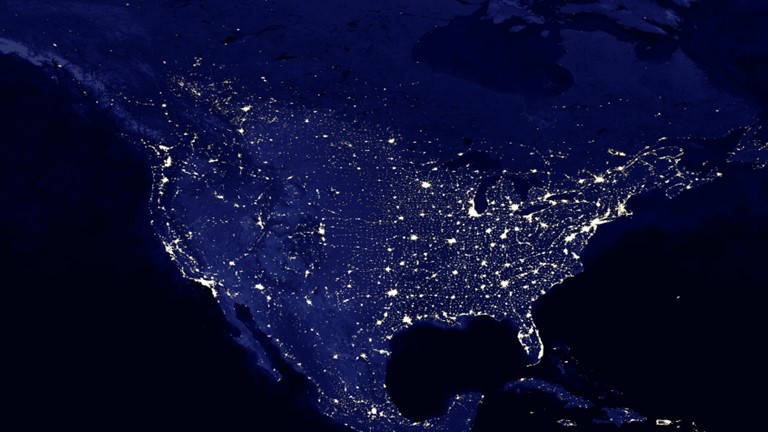
UPDATE 5.8.24: High demand for new data centers is beginning to run into the reality that with dwindling reliance on cheap coal power, America may not be capable of producing enough electricity to meet demand. Some states are second-guessing their earlier desires to lure data centers. Kevin Hardy writes in the Iowa Capital Dispatch:
Compared with other employers that states compete for, such as automotive plants, data centers hire relatively few workers. Still, states have offered massive subsidies to lure data centers — both for their enormous up-front capital investment and the cachet of bringing in big tech names such as Apple and Facebook. But as the cost of these subsidy programs balloons and data centers proliferate coast to coast, lawmakers in several states are rethinking their posture as they consider how to cope with the growing electricity demand.
From the outside, data centers can resemble ordinary warehouses. But inside, the windowless structures can house acres of computer servers used to power everything from social media to banking. The centers suck up massive amounts of energy to keep data moving and water to keep servers from overheating.
Data centers are the backbone of the increasingly digital world, and they consume a growing share of the nation’s electricity, with no signs of slowing down. The global consultancy McKinsey & Company predicts these operations will double their U.S. electric demands from 17 gigawatts in 2022 to 35 gigawatts by 2030 — enough electricity to power more than 26 million average homes.
Some states, including Maryland and Mississippi, continue to pursue incentives to land new data centers. But in other states, the growth of the industry is raising alarms over the reliability and affordability of local electric grids, and fears that utilities will meet the demand by leaning more heavily on fossil fuel generation rather than renewables.
In South Carolina, lawmakers have started to question whether these massive power users should continue to receive tax breaks and preferential electric rates.
In Virginia, home to the world’s largest concentration of data centers, a legislative study is underway to learn more about how those operations are affecting electric reliability and affordability.
And Georgia lawmakers just passed legislation that would halt the state’s tax incentives for new data centers for two years. Georgia is home to more than 50 data centers, including those supporting AT&T, Google and UPS, according to the state commerce department.
Georgia Republican state Sen. John Albers, a sponsor of the Senate bill, said the significant growth of data centers in his state has helped communities and schools by boosting property tax revenues. But, considering factors such as water and electric use, he said the return on the state’s investment “is not there” and that “initial findings do not support credits from the state level.”
Your Survival Guy has been raising the alarm over the potential that data centers for AI could consume as much as 25% of American power. Alternatively, companies selling power could benefit from all the new demand, and AI could even drive a resurrection of America’s nuclear power industry. Read more below about the grid being pushed to its limits.
Originally posted April 17, 2024.
The editors of The Wall Street Journal explain the perilous state of the Texas electric grid, writing:
Summer is two months away, yet the Texas power grid is already swooning. On Friday the Electric Reliability Council of Texas (Ercot) asked power generators to postpone scheduled maintenance early this week “to help alleviate potential tight conditions” as temperatures rise into the not-so-sizzling 80s.
The grid typically has excess power-generating capacity in the spring owing to mild weather. There’s also an abundance of solar and wind power. This is why plants go off-line for repairs in the spring to prepare for the summer when electricity use surges as people ramp up the air conditioning.
Yet merely warm spring weather is now enough to push the Texas grid to the brink. Tuesday’s high is forecast to be 89 degrees in Dallas and 84 in Houston. These temperatures shouldn’t force grid operators to break a sweat to keep the lights on, but they are.
One culprit is skyrocketing electricity demand from population growth, new data centers and manufacturing plants. A surge in Bitcoin prices has also made cypto-mining more profitable. Many miners located servers in Texas because—get this—they can arbitrage grid crunches to get paid to reduce power usage.
Data centers accounted for about 2.5% of U.S. electricity in 2022 and are expected to make up more than 20% by 2030. Artificial intelligence is magnifying this demand. A web search uses less than one watt of power while an AI-powered search can require 100 watts. Training an AI search uses around 1,000 watts.
The spring grid S.O.S. doesn’t augur well for the summer or the rest of the country. The past winter was one of the mildest on record, which eased the growing strain on the grid. Yet this summer is forecast to be one of the hottest, which means Americans will almost certainly be told to conserve power to prevent outages—i.e., don’t plan on plugging in your Tesla after getting home from work.
One risk is that power-plant maintenance that is delayed or canceled will lead to more plants failing in the summer when they are needed. Better get that emergency generator while it’s still in stock.
Action Line: With energy demand exceeding supply, and Texas being the canary in a coal mine, isn’t it time to look at the opportunity in front of you? Read more about the impact of data centers on the grid and what it means for your investments here:
- AI Data Centers Could Consume 25% of U.S. Power
- Texas Attracts Data Centers with Cheap Power and Land
- Amazon’s Nuclear Powered Data Center
- How Your Survival Guy Invests in AI and Cryptocurrencies
- Will AI Electricity Demand Resurrect Nuclear Power?
When you’re ready to talk about energy and the future of your investments, I’m here. In the meantime, click here to subscribe to my free monthly Survive & Thrive letter.



